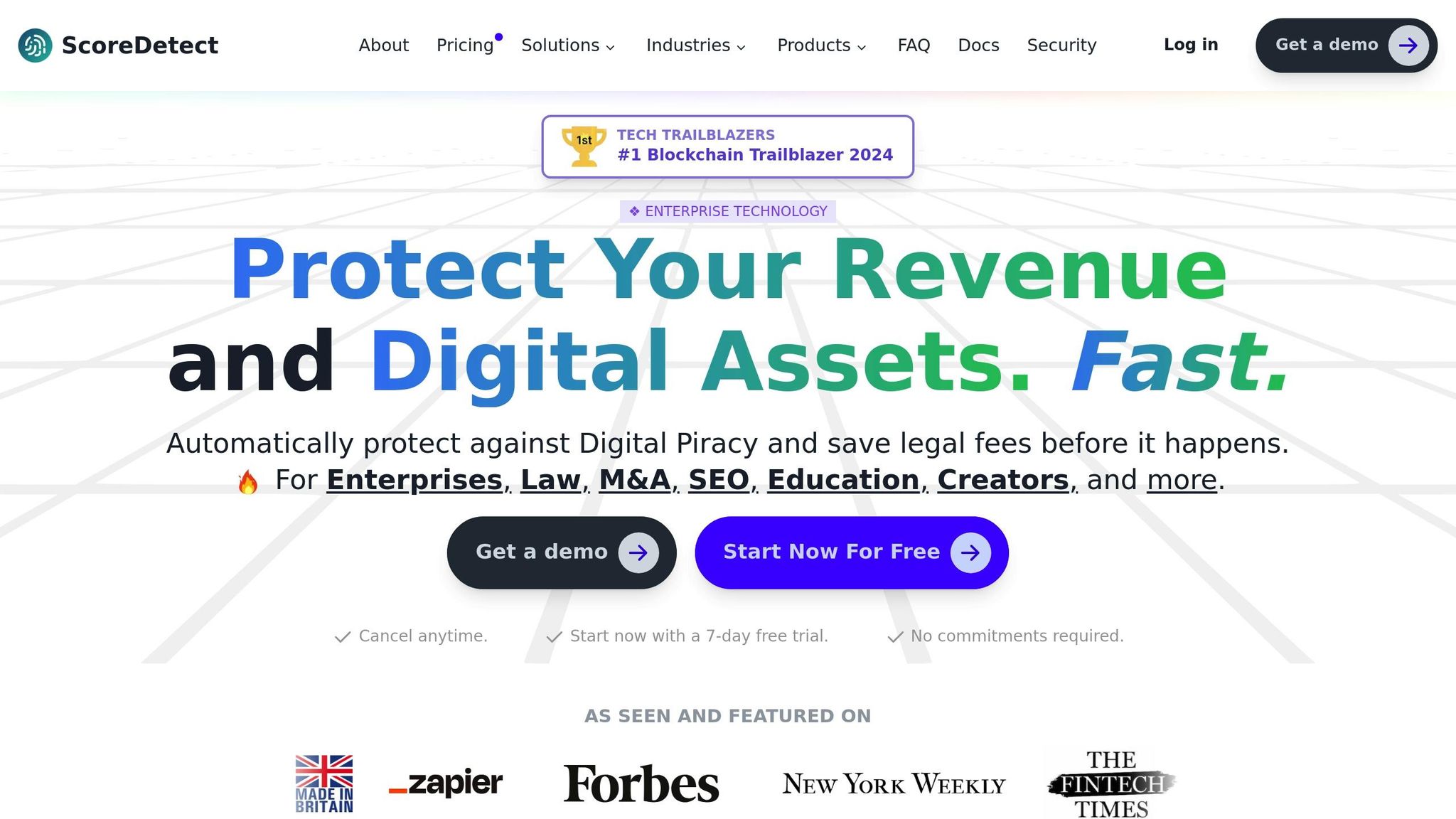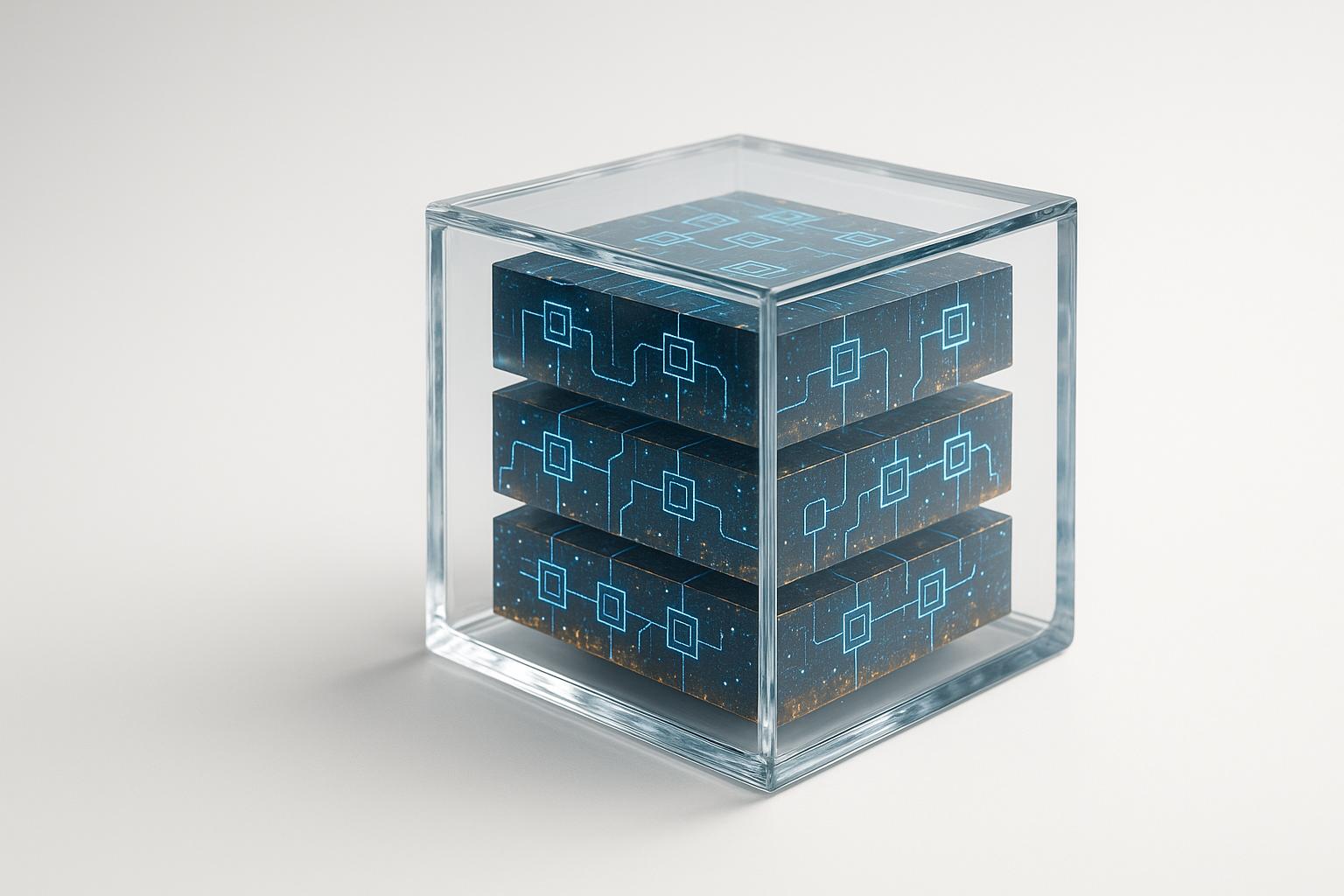Blockchain ensures data remains secure, verifiable, and unaltered, addressing modern challenges like tampering and fraud. Instead of storing files, it uses cryptographic hashes to certify the integrity of digital assets. Key benefits include tamper-proof records, automated verification, and compliance support across industries like healthcare, finance, and media. Challenges such as scalability and regulatory requirements are mitigated by advanced platforms like SKALE. Tools like ScoreDetect simplify certification with automation, web integration, and blockchain timestamping, offering a reliable way to protect and verify digital content in a fast-evolving digital landscape.
Student Certificate Validation using Blockchain | Blockchain Project
How Blockchain Protects Data Integrity
Blockchain technology employs three key mechanisms to ensure the security and integrity of digital data.
Permanent Records and Transparency
One of blockchain’s standout features is its immutable ledger. Once data is recorded on the blockchain, it cannot be altered or erased. Each entry is timestamped and linked to the previous one, forming a chain of records that creates a transparent and tamper-proof audit trail. This setup allows anyone with access to verify the authenticity of a record without needing a central authority [2][4].
Take academic credentialing as an example. When a university issues a diploma, the certificate’s details are stored on the blockchain with a permanent timestamp. Employers can then quickly verify the diploma’s authenticity, eliminating the need for time-consuming manual checks [2]. Some systems even employ a dual-chain structure – one for original records and another for authorized corrections – ensuring that data remains both unchangeable and accountable [2].
Cryptographic Hashing for Data Verification
Blockchain also uses cryptographic hashing algorithms, such as SHA256, to create unique digital fingerprints for data verification [3][6]. This process ensures that any tampering with the data becomes immediately detectable. For example, ScoreDetect applies hashing directly on the user’s device. The resulting checksum is stored on the blockchain, enabling secure verification later. If the content is re-hashed and the new hash doesn’t match the stored checksum, it’s a clear sign that the data has been altered [3].
ScoreDetect explains this method as follows:
"Your digital content is securely hashed on your device and is not saved anywhere else. Only the checksum of the digital content is saved, and placed into the blockchain." [1]
This approach ensures proof of ownership and data integrity without exposing sensitive content. Verification certificates include the checksum and the blockchain transaction URL, providing multiple layers of authentication [1].
Decentralized Consensus Mechanisms
Unlike traditional systems that rely on a single authority for validation (a potential single point of failure), blockchain uses decentralized consensus mechanisms. These mechanisms distribute trust across the network, ensuring that no single entity has control [2][10]. Protocols like proof-of-work and proof-of-stake require network participants to agree on the validity of new entries before they’re added to the ledger. This makes it extremely difficult for anyone to alter records, as doing so would require compromising the majority of the network [8][10].
Decentralized consensus removes the need for human intervention by relying on mathematical protocols and cryptographic proofs, eliminating bias and errors in the process.
For instance, ScoreDetect utilizes the SKALE blockchain, which offers an eco-conscious approach with zero gas fees and predictable costs. This partnership enables secure and efficient protection for digital content, all while maintaining the strong security of decentralized systems [1].
Steps in Blockchain-Based Data Integrity Certification
Blockchain technology offers a secure and structured approach to certifying data integrity, ensuring that digital content remains both protected and verifiable throughout its lifecycle. The process unfolds in three key steps, providing organizations with a reliable method to safeguard their valuable digital assets.
Data Submission and Validation
The journey begins with preparing and validating the data. Before anything enters the blockchain, the data must be checked for accuracy and authenticity. This step is critical because errors introduced here could compromise the entire certification process. Tools like ScoreDetect handle this locally by generating a cryptographic hash of the content without transmitting the actual files.
For sensitive or high-stakes certifications, organizations often document their verification processes to create audit trails. These trails serve as additional proof of authenticity for future reference [4]. Validation can also involve encrypting or obfuscating sensitive information to balance privacy concerns with the need for integrity verification [4].
Once the data passes validation, it’s ready for the next phase: securing a precise timestamp on the blockchain.
Blockchain Timestamping and Certification
After validation, the system moves to the timestamping and certification phase. This step records the exact time the data is added to the blockchain, creating a tamper-proof and verifiable record. A cryptographic hash of the content is generated and stored on the blockchain, ensuring privacy while offering indisputable proof of ownership and authenticity [3][4].
The certification process doesn’t store the actual content but only its checksum, which is a unique digital fingerprint. This ensures that the content remains private while still being verifiable. A certificate is issued immediately, containing all the verification details. By combining cryptographic proofs, digital signatures, and timestamps, the certification provides robust evidence of both authenticity and ownership.
Some advanced systems even offer QR codes linked directly to the blockchain record, allowing instant verification with a simple scan [8]. Additionally, blockchain’s decentralized structure ensures that at least 67% of network nodes must approve a record, significantly reducing the likelihood of fraud [8].
Once certified, the process doesn’t end. Continuous monitoring ensures that the integrity of the data remains intact over time.
Continuous Monitoring and Revision History
The final step involves ongoing monitoring and maintaining a detailed revision history. Blockchain’s immutable ledger automatically logs every data entry and modification as a new block, creating a transparent and chronological record of all changes [2][3][7].
For example, ScoreDetect’s "Revisions Timeline" feature allows users to track changes transparently [1]. By comparing current data against the original blockchain-stored checksums, any alteration generates a new cryptographic hash. This immediately highlights discrepancies, ensuring that data integrity is preserved.
Keeping subscriptions active is essential to maintain verification links [1]. Regular monitoring not only helps organizations stay compliant with evolving standards but also provides stakeholders with the transparency needed to verify data authenticity [2].
This structured approach to blockchain-based certification offers a dependable framework for maintaining data integrity, ensuring that all authorized parties can review and trust the information at any time.
sbb-itb-738ac1e
Benefits and Challenges of Blockchain for Data Integrity
This section explores how blockchain technology supports data integrity certification while also highlighting the hurdles organizations face when implementing it effectively.
Benefits of Blockchain-Based Certification
Blockchain offers several advantages for ensuring data integrity:
- Tamper-resistance: Once data is added to the blockchain, it’s nearly impossible to alter or delete without leaving a trace. This is due to the cryptographic links between blocks, which make any unauthorized changes immediately detectable [2][3][10]. This feature gives organizations confidence in the long-term authenticity of their certified data.
- Transparency: Blockchain’s distributed ledger allows all authorized participants to access and verify transactions in real-time. This reduces the need for intermediaries and cuts down verification delays, transforming processes that once took days into mere seconds [2][6].
- Enhanced auditability: Blockchain creates a permanent, detailed record of every data interaction. Unlike traditional systems, where audit trails can be tampered with or lost, blockchain preserves an unchangeable history of all transactions [7]. For instance, healthcare organizations use this feature to secure patient records, ensuring compliance and traceability [6].
- Increased trust: Blockchain’s decentralized verification process eliminates reliance on a single authority. With at least 67% of network nodes required to approve changes, the risk of fraud is significantly reduced [8]. This builds confidence across all stakeholders involved in data certification.
- Efficiency gains: Automating compliance workflows and eliminating manual verification processes save time and resources, offering operational advantages to organizations.
Challenges and Best Practices
While blockchain provides robust benefits, it also comes with challenges that require thoughtful strategies to address.
- Data origin risks: Blockchain can confirm that data hasn’t been altered since it was recorded, but it cannot verify the accuracy of the original data itself [5][9]. To address this, organizations need to adopt secure data entry protocols and validate sources before adding information to the blockchain. Third-party audits, like those offered by certification bodies, can add an extra layer of assurance by verifying data before it’s recorded [7][9]. For example, ScoreDetect uses AI-driven analysis and watermarking to ensure data accuracy before capturing checksums on the blockchain [3].
- Scalability concerns: High transaction volumes or large data sets can strain some blockchain systems [2]. Modern solutions, however, are tackling these issues. For instance, ScoreDetect’s partnership with the SKALE blockchain enables lightning-fast verification certificates, with speeds improved by 170% [1]. Choosing platforms like Ethereum or Hyperledger Fabric and optimizing smart contracts can help organizations handle growing demands efficiently [2].
- Regulatory adaptation: Compliance with privacy laws such as GDPR and CCPA requires careful management of sensitive data. Blockchain systems should only store hashes or metadata, not personal information, to meet these requirements [3][4].
- Cost concerns: Traditional blockchain platforms often come with high energy usage and transaction fees. However, newer platforms like SKALE address this with zero gas fees and sustainable cost models [1].
- Integration complexity: Adopting blockchain can be daunting, but modular tools are simplifying the process. For example, ScoreDetect’s WordPress plugin automatically records published or updated articles, creating blockchain-based proof of ownership and enhancing SEO. This kind of seamless integration removes technical barriers and delivers immediate value.
| Challenge | Best Practice Solution | Example Implementation |
|---|---|---|
| Data Origin Risks | Use validation protocols and audits | AI-driven verification before blockchain entry |
| Scalability Issues | Choose scalable platforms, optimize design | SKALE blockchain for faster verification |
| Regulatory Compliance | Encrypt sensitive data | Store hashes instead of raw content |
| Integration Complexity | Leverage modular tools | WordPress plugin for automated certification |
How ScoreDetect Improves Data Integrity Certification

ScoreDetect takes blockchain certification to the next level by using AI-powered cryptographic verification to protect digital content. This approach tackles challenges faced by industries across multiple sectors with precision and efficiency.
Blockchain-Powered Content Protection
At the core of ScoreDetect’s data integrity certification process is its use of cryptographic checksums. These checksums are recorded on a blockchain, creating tamper-evident, time-stamped proof of ownership and existence – all without storing the actual content itself. This ensures an indisputable record of authenticity.
To enhance security further, ScoreDetect employs invisible and non-invasive watermarking technology. This works hand-in-hand with blockchain certification to deter unauthorized use. Together, these two layers of protection not only prevent misuse but also provide undeniable proof when violations occur.
The platform also uses sophisticated web scraping technology with an impressive 95% success rate in bypassing detection systems. This enables organizations to monitor the internet for unauthorized use of their protected content effectively. When violations are identified, ScoreDetect’s automated takedown processes kick in, achieving a 96% success rate in resolving such issues swiftly.
When disputes arise, ScoreDetect’s checksum verification system becomes invaluable. Blockchain-stored hashes can be compared to current assets to determine if tampering occurred. This process provides court-admissible proof of ownership and originality, making it an essential tool for copyright enforcement and legal proceedings. The dual-layered approach also supports streamlined automation for better compliance management.
Automation and Integration for Compliance
ScoreDetect simplifies data integrity certification through automation, reducing manual workloads and minimizing errors. With integration capabilities for over 6,000 web apps via Zapier, the platform automates content protection and certification seamlessly.
One standout feature is the WordPress plugin, which automatically safeguards content while also boosting SEO performance. By establishing clear authorship and originality signals, the plugin helps improve search engine rankings, giving content creators and publishers an added advantage.
Organizations can also create customized automated workflows tailored to their compliance needs. For instance, a media company might configure workflows to watermark new videos, generate blockchain certificates, and monitor for unauthorized distribution across multiple platforms – all at once. This level of automation significantly reduces the time and resources needed for thorough content protection.
Verification certificates issued by ScoreDetect include registration dates, SHA256 hashes, blockchain URLs, and official signatures. These documents serve as formal proof of compliance and can be exported as PDFs for easy sharing with stakeholders, auditors, or legal teams.
Additionally, Formal Recognition Certificates provide extra compliance support. These include official letters explaining the blockchain timestamping process and asserting ownership rights, which are especially valuable for organizations in regulated industries where proof of data integrity is critical.
Business Applications Across Industries
By combining blockchain certification with advanced content protection and automation, ScoreDetect addresses the data integrity needs of a wide range of industries.
- Media and Entertainment: Tackle digital piracy and establish ownership of creative works.
- Marketing and SEO Agencies: Validate campaign originality while gaining SEO advantages through stronger Google E-E-A-T signals.
- Research and Academia: Protect intellectual property and certify the authenticity of publications.
- Legal and Law Firms: Provide tamper-proof evidence for legal cases.
- Healthcare: Ensure the integrity of patient records while maintaining privacy compliance.
- Financial Services: Certify transaction records and compliance documents for regulatory purposes.
For enterprise clients, ScoreDetect offers features like 24/7 content monitoring, dedicated success managers, and white-labeling options. Businesses can integrate these capabilities into their current systems with ease, while custom domain options and private Slack channels provide tailored support and flexibility. These enterprise-level tools make ScoreDetect a versatile solution for diverse business needs.
The Future of Data Integrity Certification with Blockchain
Blockchain is steadily becoming a cornerstone of data integrity certification, and its potential for strengthening digital trust is only growing. By combining unchangeable ledgers, advanced cryptographic tools, and automated processes, blockchain is changing how organizations safeguard and validate their digital assets. This progress is particularly timely, as it offers solutions to emerging challenges like deepfakes and AI-generated content.
In an era dominated by AI and synthetic media, verifying authenticity is more important than ever. Blockchain’s ability to create unalterable records serves as a powerful tool for instantly confirming content ownership and originality. For businesses, this means a reliable way to build trust and establish credibility in a landscape where artificial content can easily erode confidence.
The move toward eco-conscious blockchain platforms marks another leap forward, making data integrity certification both more sustainable and affordable. Zero gas fee networks eliminate the unpredictable costs often tied to blockchain transactions. This shift ensures that even smaller organizations can adopt certification processes without breaking the bank. At the same time, regulatory frameworks are evolving to accommodate these transparent, energy-efficient technologies.
Legal recognition and regulatory compliance are also gaining momentum as blockchain certificates become widely accepted across industries and jurisdictions. The transparent and tamper-proof nature of blockchain records aligns with U.S. regulations in sectors like finance, healthcare, and digital copyright. Additionally, blockchain’s detailed audit trails simplify compliance reporting and offer strong legal protection.
Advancements in integration are set to make blockchain certification even more accessible. Enhanced automation and workflow tools will allow organizations to implement content protection measures without needing deep technical expertise. Privacy-preserving methods will also address concerns about data security, ensuring transparency without compromising sensitive information.
The future of blockchain-based certification extends beyond traditional documents, encompassing a variety of digital assets such as multimedia files, research papers, and proprietary business materials. As interoperability standards improve and integration becomes more seamless, blockchain will revolutionize how industries – from media and entertainment to healthcare and finance – build trust and safeguard intellectual property in the digital world. With solutions like ScoreDetect already paving the way, blockchain is set to become an essential component of content protection strategies.
In the near future, data integrity certification could become as commonplace as password protection, with blockchain serving as the backbone for trustworthy and efficient digital asset management.
FAQs
How does blockchain protect sensitive data while ensuring its integrity?
Blockchain technology ensures data integrity through the use of a checksum – a distinct digital fingerprint that represents the content. Importantly, the actual digital assets aren’t stored on the blockchain. This means sensitive information stays private and securely with the owner, while still enabling verifiable proof of ownership and authenticity.
This method allows blockchain to safeguard data integrity, supporting secure certification processes without revealing or risking the original content.
What challenges can arise when using blockchain for data integrity certification, and how can they be addressed?
Implementing blockchain for certifying data integrity isn’t without its hurdles. Common challenges include scalability, energy demands, and the complexity of integrating blockchain with existing systems. Scalability issues often emerge when dealing with a high volume of transactions, while some blockchain protocols can consume significant energy. On top of that, integrating blockchain into older systems can require a lot of time and resources.
That said, these obstacles aren’t insurmountable. Opting for energy-efficient blockchain protocols, like those using proof-of-stake, can address energy concerns. Additionally, platforms designed to simplify integration can make the process smoother. For example, ScoreDetect strengthens copyright protection by using blockchain to record a checksum of the content rather than storing the actual digital assets. This method is both secure and resource-efficient, reducing the strain on systems. By pairing blockchain with advanced tools and workflows, organizations can achieve reliable data integrity certification with minimal disruption to their operations.
How does blockchain-based data integrity certification benefit industries like healthcare and finance?
Blockchain-based data integrity certification provides industries such as healthcare and finance with a reliable method to secure and verify sensitive information. Instead of storing the actual data, this system records a checksum of digital assets on the blockchain, ensuring the data’s authenticity and integrity.
This method strengthens the protection of intellectual property, reinforces copyright security, and promotes trust in how data is managed. It’s especially useful for securing patient records, financial transactions, and other crucial information in a way that’s both transparent and resistant to tampering.

